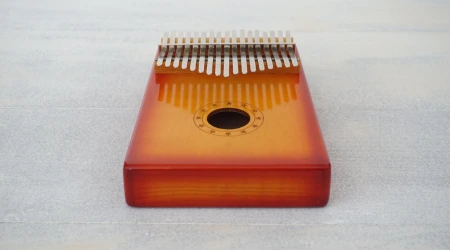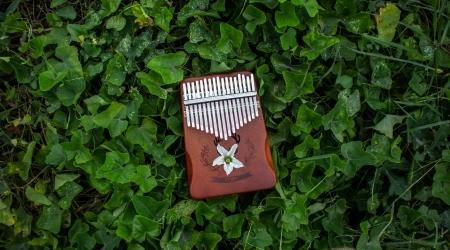Kalimba: An African Instrument That Delights With Simplicity

THE kalimba It's more than a musical instrument—it's a bridge between cultures, histories, and emotions. With its metallic keys and delicate resonance, it captivates beginners and experienced musicians alike.
Advertisements
Originating in Africa, its simplicity hides a rich sound capable of conveying feelings without words. But what makes it a global phenomenon in 2025?
The answer lies in the unique combination of tradition and modernity.
While maintaining its ancestral essence, the kalimba has adapted to contemporary demands, appearing in soundtracks, musical therapies and even digital productions.
If you are looking for an affordable, therapeutic and personality-filled instrument, kalimba might be the perfect choice. Let's explore its history, techniques, and influence on contemporary music.
Advertisements
The Historical Journey of the Kalimba
Known as mbira in countries like Zimbabwe, the kalimba has deep roots in African tradition.
Similar instruments were already in use more than 3,000 years ago, according to archaeological records found in the Zambezi Valley.
Its primitive structure was made of bamboo or metal, attached to a gourd that amplified the sound.
Over time, Bantu communities took it to different regions, adapting its shape and function in rituals and celebrations.
In the 20th century, ethnomusicologist Hugh Tracey popularized the kalimba in the West, creating standardized models in steel.
His company, Hugh Tracey Kalimba, still produces instruments true to tradition, while experimental artists take it into new genres.
Today, the kalimba It is a symbol of cultural resistance. In 2024, the Geneva Museum of Ethnography included an exhibition dedicated to the instrument, highlighting its role in the African diaspora.
Why Does the Kalimba Fascinate So Much?
Its magic lies in its accessibility. Unlike a violin or piano, which require years of practice, kalimba allows you to create harmonious melodies in just a few weeks.
Simply slide your thumbs over the slides—and the music flows. This ease of use makes it ideal for children, the elderly, and even musicians recovering from motor impairments.
++Have You Heard of the Hang Drum? The Hypnotic Sound of Steel
A study of University of South Africa (2023) showed that touching kalimba reduces stress by 34% for practitioners. The vibration of the notes creates a sound therapy, connecting body and mind in an almost meditative way.
Furthermore, its unique timbre—sweet yet percussive—makes it versatile. It can accompany everything from mantras to electronic beats, as the Nigerian producer did. You have on his latest album.
From Folk to Pop: Modern Versatility
Artists like Ombachi and Lara Klaus reinvented the use of kalimba in contemporary music.
In “Spirits”, from the album Horizons (2024), Ombachi mixes electronics with the organic timbre of the instrument, creating a unique soundscape.
She even makes her presence felt in the cinema. The Last Breath (2025), the soundtrack uses the kalimba to convey nostalgia and hope. Her musical voice is as flexible as a river—adapting to any current.
In Brazil, bands like Maglore incorporated the kalimba in indie arrangements, proving that there are no limits to its application. Even DJs use it in live sets, connecting the ancestral to the digital.
How to Choose Your First Kalimba?
Models vary in size, tuning, and material. Beginners should opt for versions in C major, with 17 keys—a balance between simplicity and possibilities.
Brands like Gecko and Meinl offer durable options without breaking the bank. Kalimba Bamboo, for example, combines sustainability and sound quality, making it ideal for those looking for a warmer sound.
++How to Clean Atabaque Skins Without Damaging Them
Avoid very cheap versions, as tuning errors can frustrate your learning curve. A tip is to test before buying: the keys should respond evenly to your touch.
For those who want to invest, professional models of Hugh Tracey or Chill Angels guarantee precision and durability.
Techniques to Extract the Best Sound
Cup your hands to amplify resonance. Use your thumbs in gentle movements—excessive pressure distorts the notes.
Experiment with rhythmic patterns before complicating the melodies. Start with simple scales, then explore more complex harmonies.
For a sweeter sound, touch your fingernails to the edges of the keys. Want something more percussive? Tap the soundboard lightly as you play.
Artists like Pierre Minetti recommend recording your sessions to identify areas for improvement. Daily practice, even for 10 minutes, accelerates progress.

Kalimba in Digital Culture
Platforms like TikTok and YouTube have gone viral with covers and tutorials. The hashtag #KalimbaTutorial has already accumulated 2.1 million views, demonstrating its global appeal.
Specialized channels, such as Kalimba Magic, offer free sheet music and maintenance tips. The online community has transformed an ancient instrument into a modern phenomenon.
Apps like Real Kalimba They simulate the instrument on smartphones, democratizing access. They don't replace the tactile experience, but they're great for training your ear and rhythm.
Kalimba in Music Therapy: Healing Through Vibrations
In recent years, the kalimba gained prominence as a therapeutic tool in rehabilitation clinics and wellness centers.
Its gentle sound and rhythmic vibrations have been used to help treat anxiety, insomnia, and even mild cases of depression.
++Top 5 Professional Tambourines Up to R$1,000,000
Music therapists observed that patients who interact with the instrument show a reduction in cortisol levels, according to a study published in Journal of Music Therapy (2024).
Regular practice has been shown to improve concentration and fine motor coordination, and is especially beneficial for the elderly and people recovering from stroke.
Customizing Your Kalimba: Tips for a Unique Touch
Just as a guitar can be customized, kalimba also allows for customizations that reflect your musical identity.
Experienced musicians often adjust the tuning to unconventional scales, creating unique sonic atmospheres.
Some enthusiasts decorate the soundboard with paint or stickers, while others experiment with different materials on the keys.
Replacing the lamellas with bronze or copper versions, for example, significantly changes the timbre, offering deeper bass or more crystal-clear highs.
Specialty stores like Kalimba World offer modification kits for those who want to explore these possibilities.
Frequently Asked Questions
1. Is the kalimba difficult to learn?
No—it's one of the most accessible instruments for beginners. With regular practice, you can play simple songs in just a few weeks.
2. What is the difference between kalimba and mbira?
THE kalimba It is a modern variation of the mbira, with wider keys and Westernized tuning. The traditional mbira has a more metallic sound and is used in rituals.
3. Do I need to tune my kalimba often?
Yes, especially on cheaper models. Use a digital tuner and adjust the keys with a special hammer.
4. Can I play any song on the kalimba?
Almost all of them! As long as they're in the scale of your instrument. Adapted sheet music is available online.
Conclusion: An Invitation to Experiment
THE kalimba proves that beauty lies in simplicity. Whether as a hobby, therapy, or artistic expression, it offers a sonic universe waiting to be explored.
How about starting your journey today? After all, how many instruments combine ancient tradition and innovation so effortlessly?
With its portability, affordable cost and captivating timbre, the kalimba is proof that music doesn't have to be complicated to be profound.
